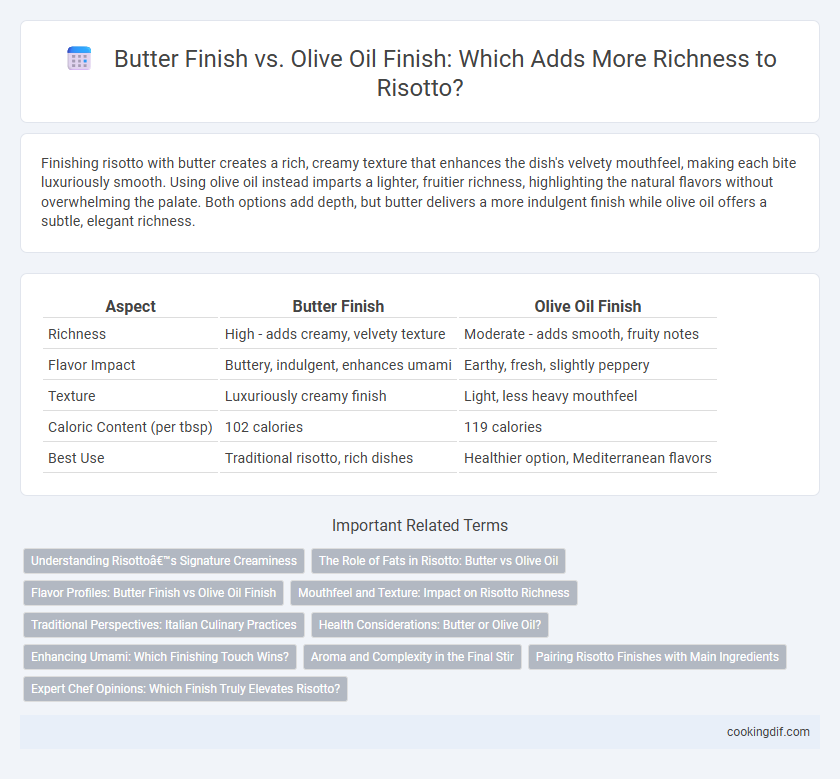Finishing risotto with butter creates a rich, creamy texture that enhances the dish's velvety mouthfeel, making each bite luxuriously smooth. Using olive oil instead imparts a lighter, fruitier richness, highlighting the natural flavors without overwhelming the palate. Both options add depth, but butter delivers a more indulgent finish while olive oil offers a subtle, elegant richness.
Table of Comparison
| Aspect | Butter Finish | Olive Oil Finish |
|---|---|---|
| Richness | High - adds creamy, velvety texture | Moderate - adds smooth, fruity notes |
| Flavor Impact | Buttery, indulgent, enhances umami | Earthy, fresh, slightly peppery |
| Texture | Luxuriously creamy finish | Light, less heavy mouthfeel |
| Caloric Content (per tbsp) | 102 calories | 119 calories |
| Best Use | Traditional risotto, rich dishes | Healthier option, Mediterranean flavors |
Understanding Risotto’s Signature Creaminess
Butter finish enhances risotto's signature creaminess by adding a rich, velvety texture that olive oil cannot replicate. The milk fats in butter emulsify the starches released from the rice, creating a luscious mouthfeel essential to traditional risotto. Olive oil, while providing a lighter, fruitier flavor, lacks the same ability to achieve the deep, creamy richness characteristic of classic risotto dishes.
The Role of Fats in Risotto: Butter vs Olive Oil
The role of fats in risotto crucially impacts its richness and mouthfeel, with butter providing a creamy, luxurious texture that enhances the dish's velvety consistency. Olive oil, particularly extra virgin, offers a lighter finish with fruity and aromatic notes, contributing to a subtler depth without overpowering the rice's natural flavor. Choosing butter versus olive oil depends on the desired richness: butter delivers indulgent smoothness, while olive oil emphasizes freshness and a balanced, nuanced taste.
Flavor Profiles: Butter Finish vs Olive Oil Finish
A butter finish in risotto enhances creaminess with a rich, velvety texture and imparts a slightly nutty, sweet flavor that deepens the dish's overall taste complexity. Olive oil finish offers a lighter, fruitier aroma with subtle grassy and peppery notes, contributing a fresh, Mediterranean essence without overwhelming the delicate risotto base. Choosing butter emphasizes decadence and smooth mouthfeel, while olive oil highlights brightness and a nuanced herbal character in the flavor profile.
Mouthfeel and Texture: Impact on Risotto Richness
Butter finish enhances risotto's mouthfeel by adding a creamy, velvety texture that contributes to a richer, more indulgent experience. Olive oil finish offers a lighter, silkier texture that preserves the grain's bite while imparting subtle fruitiness, balancing richness without heaviness. Choosing butter maximizes decadence, whereas olive oil finishes maintain a refined, textured mouthfeel with moderate richness.
Traditional Perspectives: Italian Culinary Practices
Traditional Italian risotto recipes often use butter for finishing to enhance creaminess and deliver a rich mouthfeel, aligning with regional culinary customs like those in Lombardy. Olive oil, preferred in Mediterranean areas such as Liguria, imparts a fruitier flavor and lighter texture, emphasizing freshness over heaviness. The choice reflects local ingredient availability and cultural preferences, with butter representing a luxurious richness and olive oil a vibrant, traditional finish in authentic Italian cooking.
Health Considerations: Butter or Olive Oil?
Butter finish in risotto enhances richness with saturated fats and fat-soluble vitamins, contributing to a creamy texture but higher cholesterol levels. Olive oil finish offers heart-healthy monounsaturated fats and antioxidants, promoting better cardiovascular health while yielding a lighter mouthfeel. Choosing olive oil favors health-conscious diets by reducing saturated fat intake without compromising essential flavors.
Enhancing Umami: Which Finishing Touch Wins?
Butter finish in risotto creates a creamy, velvety texture that amplifies umami by blending with Parmesan's savory depth, resulting in a rich mouthfeel. Olive oil finish offers a lighter, fruity note that subtly elevates umami through its natural antioxidants and slightly grassy flavor, preserving the dish's freshness. For maximum umami enhancement and richness, butter finish tends to be preferred, delivering a more indulgent, creamy experience.
Aroma and Complexity in the Final Stir
Butter finish in risotto enhances richness by adding a creamy texture and a nutty aroma, deepening the flavor profile with its complex dairy notes. Olive oil finish, on the other hand, imparts a fruity, slightly peppery aroma, contributing to a lighter, more herbaceous complexity in the final stir. Choosing butter intensifies luxurious mouthfeel and warmth, while olive oil elevates freshness and aromatic complexity without overwhelming the dish.
Pairing Risotto Finishes with Main Ingredients
Butter finish enhances risotto with a creamy, rich texture that complements earthy flavors like mushrooms, game, and aged cheeses. Olive oil finish offers a lighter, fruitier profile ideal for seafood, vegetables, and herbal infusions, allowing freshness to shine. Selecting the finish based on the main ingredient elevates the dish by balancing richness and flavor harmony.
Expert Chef Opinions: Which Finish Truly Elevates Risotto?
Expert chefs often debate the impact of butter versus olive oil as a finishing touch for risotto, with many favoring butter for its luxurious creaminess and ability to enhance the dish's richness through its natural milk fats. Olive oil, particularly extra virgin, is praised for imparting a lighter, fruitier note and adding subtle complexity without overwhelming the delicate texture of the rice. Culinary authorities agree that while butter delivers a classic, velvety finish ideal for traditional risottos, high-quality olive oil provides a nuanced alternative that can elevate modern or vegetable-forward variations.
Butter finish vs olive oil finish for richness Infographic

 cookingdif.com
cookingdif.com